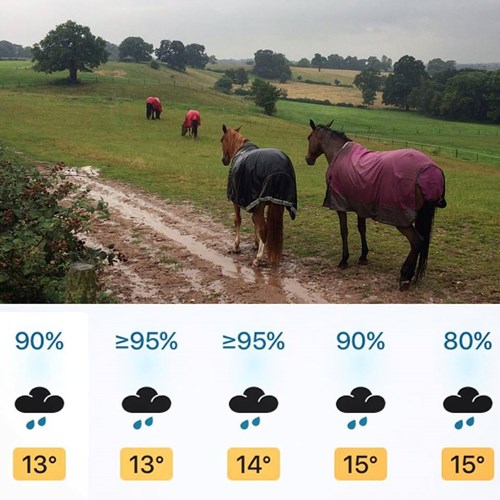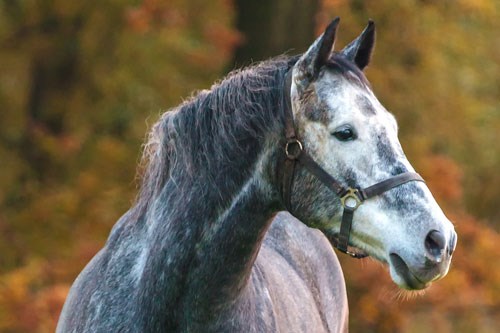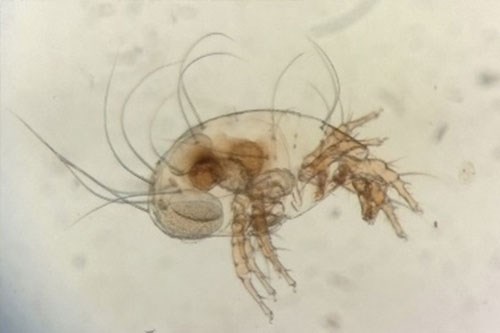
Our horses have carefully targeted worming programmes; we poo pick our paddocks; quarantine new horses and rotate our grazing, yet one of the biggest influencers of parasite burdens is unfortunately something we can do nothing about! The weather, most noticeably temperatures and rainfall, have a massive impact on the worms in our horses.

It’s so influential that the National Animal Disease Information Service issues a monthly Parasite Forecast for farmers based on detailed Met Office data. The forecast tracks weather variations to highlight potential risks for sheep and cattle.
Generally the milder and wetter the better for parasites; warm weather is convivial for activities like feeding and breeding and the damp weather keeps everything motile and ticking along.
Spring and Autumn are naturally times of the year when parasites thrive. Ideally what we need our weather to deliver is extremes either side of this - cold, hard winters and hot, dry summers to stop parasites in their tracks.

Rainfall and moisture levels
In optimal conditions the most numerous of horse parasites, the redworm, can develop from an egg laid in a dung pile to its infective larval stage in as little as five days.
In this time the tiny worm larvae, so small it’s barely visible to the naked eye, can travel about one metre. Impressive enough until we get some rainfall and this multiplies to up to three metres of getaway potential in wet conditions!
This is important for survival; most horses won’t choose to graze near droppings so the further away a larvae can wriggle to a tempting blade of grass, the more likely its chance of being eaten by a potential host to continue its life cycle.
In contrast hot, arid conditions, of the sort we get very little of here in the UK, spell disaster. Moisture deficit will slow, or even halt, development of the worm larvae and desiccate dung piles, exposing eggs to lethal rays of UV light.
This makes harrowing a useful method of parasite control but only in these conditions! Where there is any moisture present, it will merely serve to spread worm eggs around the pasture, allowing the larvae to penetrate into the protective vegetative layer.
Temperature
Worm eggs are generally made of pretty tough stuff, non-more so than roundworm eggs. The thick, sticky shell of the ascarid helps it to survive temperature extremes in the UK environment for up to 10 years. A portion of redworm eggs will also overwinter, enduring hard frosts to hatch in spring when the warmer weather comes along.

An orabatid mite
Frost is effective at killing off tapeworm eggs but this doesn’t mean one good winter will eradicate them. Tapeworm have an intermediate host – tiny orabatid mites which are adept at wintering in British climes. There will be plenty of these infected grassland mites to see the species through the colder months.
Temperature also affects the worms themselves. Redworm activity slows considerably below 6 ◦C and development from egg into an infective larval stage could take several weeks in winter weather. Some however, will find a way to ride out the winter chill until ingested by a horse, where the warm internal temperatures spark them into action and perpetuate the lifecycle.
Protecting our horses
Given normal UK weather a healthy adult horse can follow a very simple plan of testing and dosing, worm egg counting Spring Summer and Autumn, tapeworm testing every 6 months and giving a proactive winter dose for the possibility of encysted redworm.
However an unseasonably mild winter and a wet summer can significantly increase the risk of dangerous parasite burdens. in these sustained warm, wet conditions we need to be extra careful about monitoring our horses and consider reducing the time between worm counts to 8 weeks particularly with young, old or vulnerable horses.
We should also be aiming to break the lifecycle of the worms mechanically as much as possible with pasture management and be ready to step in with the right chemical at the right time if necessary to ensure parasite levels don’t rise to a level where they might prove damaging to horse health.